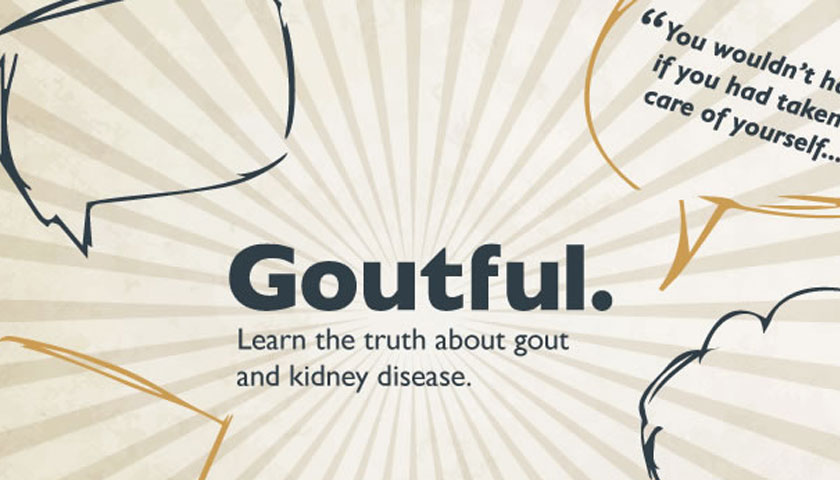Aiming to demystify gout, an extremely painful form of inflammatory arthritis, the American Kidney Fund (AKF) today unveiled a new health education campaign, Goutful. The campaign debunks popular misconceptions about gout and supports kidney patients who are fighting this painful, chronic disease.
A strong correlation exists between chronic kidney disease (CKD) and gout. Gout occurs when high levels of uric acid in the blood lead to crystals forming in the joints, causing inflammation and pain. One in 10 CKD patients has gout.
Goutful is a play on “doubtful” and uses an educational webpage, artwork and a “Myths & Facts” quiz to debunk many of the misconceptions people have about gout—including the common beliefs that gout is the patient’s fault and that gout isn’t a serious condition. The campaign is part of AKF’s ongoing work to provide quality health education content to the CKD community and is supported by an educational grant from Horizon Pharma.
“This campaign is meant to empower gout sufferers with knowledge to help them live easier and prevent further damage to their joints,” said LaVarne A. Burton, president and chief executive officer of the American Kidney Fund. “Although it can be excruciatingly painful, gout is often not taken seriously, and the patient is blamed for the condition because it is perceived to be a result of the patient’s choices. People affected by gout need resources to teach them how to manage symptoms and the painful attacks that can develop suddenly.”
Gout attacks, also known as flare-ups, may occur when the body creates too much uric acid or cannot properly clear uric acid. In addition to being painful, gout flare-ups can be hard to control and often disrupt daily life such as work and family activities.
Goutful dispels the following common myths associated with gout:
- Myth 1: “You wouldn’t have gout if you had taken better care of yourself…”
- Truth: Having gout is not the patient’s fault. There may be certain foods patients should avoid if they are prone to gout, and certain foods may help decrease the level of uric acid in a patient’s body, but diet alone is not a cure. People with gout who follow a healthy diet may still need medicines to prevent gout attacks by lowering the level of uric acid in their body.
- Myth 2: “It’s just a pain in your toe…”
- Truth: Gout can develop in all the joints in a person’s body and cause extremely severe pain. The big toe is the most common place for gout attacks to happen, but can happen in the hands, elbows, knees, and ankles. When people have chronic gout, often several of their joints are affected.
- Myth 3: “If I can’t feel it, it can’t hurt me.”
- Truth: Gout causes damage even when a patient is not having an attack. Symptoms of a gout attack often go away within a few days but gout is still there. Even if people don’t feel symptoms, urate crystals in the body can cause long-term health problems like joint and kidney damage.
- Myth 4: “I don’t need to take medicine to prevent gout if I have just a few attacks a year…”
- Truth: Medicine can prevent the internal damage that chronic gout causes.
“With so much misinformation about gout, we’re hopeful our Goutful campaign will bring much-needed clarity to so many who struggle with this debilitating condition,” Burton said. “We are grateful for the generous support of Horizon Pharma which enabled us to develop a powerful—and empowering—campaign.”
For more information about AKF’s gout campaign, visit www.KidneyFund.org/gout.

